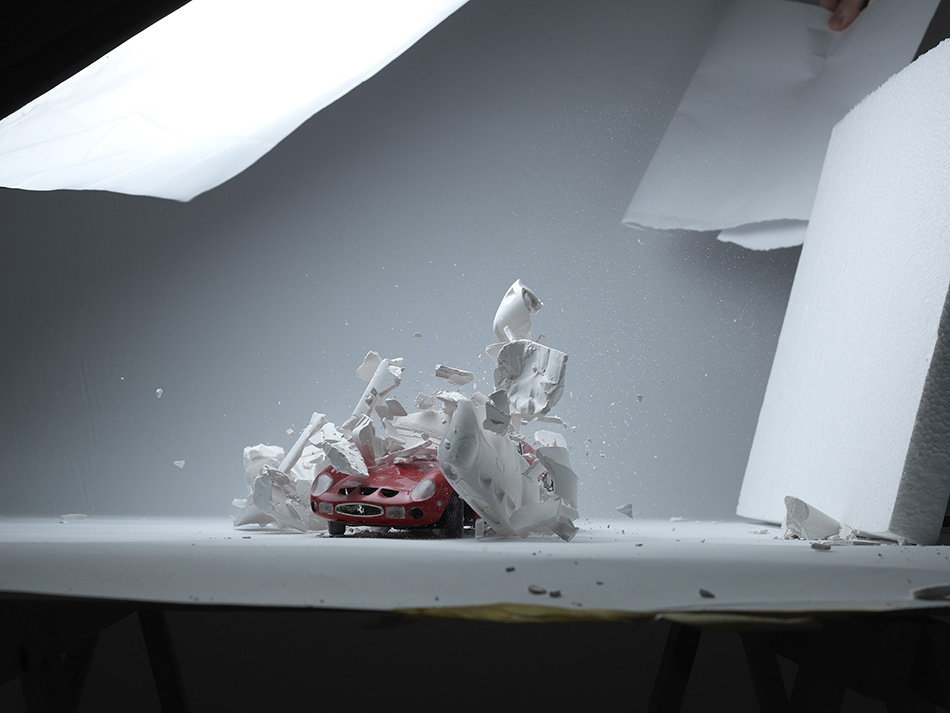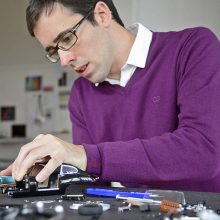Don’t worry, no classic cars were harmed in the making of Swiss artist Fabian Oefner’s images.
Oefner is known for his ability to fuse art and science. His latest work involves classic cars — their creation and their destruction.
“What you see in these images is a moment that never existed in real life,” he said in a news release from the MF&B M.A.D. Gallery in Geneva, Switzerland, where Oefner’s work is on display through May. (M.A.D. is short for Mechanical Art Devices.)
“What looks like a car falling apart is in fact a moment in time that has been created artificially by blending hundreds of individual images together. There is a unique pleasure about artificially baulking a moment… Freezing a moment in time is stupefying.”
The images in Oefner’s Disintegrating series show the demise of three classic sports cars — a 1967 Ferrari 330 P4, a 1961 Jaguar E-type coupe and a 1954 Mercedes-Benz 300 SRL Uhlenhaut coupe.
On the other hand, his Hatch series explores “the birth of a car” as if the car was actually hatching.
Oefner said Hatch was inspired by an image he saw of a hatching chick. He wanted to explore how it might look if a manufactured object was born like a living organism. His choice of object was a Ferrari 250 GTO.
For Disintegrating, the news release reports, Oefner “first sketched on paper where the individual pieces would go, before taking apart the model cars piece by piece, from the body shell right down to the minuscule screws. Each car contained over a thousand components.
“Then, according to his initial sketch, he placed each piece individually with the aid of fine needles and pieces of string. After meticulously working out the angle of each shot and establishing the right lighting, he photographed the component, and took thousands of photographs to create each Disintegrating image.
“All these individual photos were then blended together in post-production to create one single image. With the wheels acting as a reference point, each part was masked in Photoshop, cut and then pasted into the final image.
“These are possibly the ‘slowest high-speed’ images ever captured,” he said. “It took almost two months to create an image that looks as if it was captured in a fraction of a second. The whole disassembly in itself took more than a day for each car due to the complexity of the models. But that’s a bit of a boy thing. There’s an enjoyment in the analysis, discovering something by taking it apart, like peeling an onion.”
In Hatch, Oefner “presents his interpretation of how cars might be ‘born’. The first two images show a Ferrari 250 GTO – again a detailed scale model – breaking out of its shell. The third image shows one of the empty shells left behind among several others yet to hatch”
Oefner started with a latex mold of the model car. The mold was filled with a thin layer of gypsum to create a shell.
“Several dozens of these shells were made in order to complete the next step: smashing the shell onto the car to create the illusion of the vehicle breaking out. This step had to be repeated a great many times until the desired results were achieved.
“To capture the very moment where the shell hit the model, Fabian connected a microphone to his camera, a Hasselblad H4D, and flashes, so that every time the shell hit the surface of the car, the impulse was picked up by the microphone which then triggered the flashes and the camera shutter.
Oefner, who turns 30 in 2014, was 14 when he saw Harold Edgerton’s photo of a bullet piercing an apple. The photo inspired Oefner to buy his first camera.
“I have always experimented with all different kinds of art forms,” he said. “Photography turned out to be the form of art that I was most interested in.”
His previous work includes photographing “nebulae’”formed in a fiberglass lamp and bursting balloons filled with corn starch. He has photographed crystals of color rising in reaction to a speaker’s sound waves, captured the patterns created by magnetic ferrofluids pushing paint into canals, and taken color-crazy photos of paint modeled by centripetal forces.
“I am trying to show these phenomena in an unseen and poetic way,” he pauses, “and therefore make the viewer pause for a moment and appreciate the magic that constantly surrounds us.”
Oefner shared his ideas and artwork during a TED Talk, which includes several of his non-automotive of his images.








